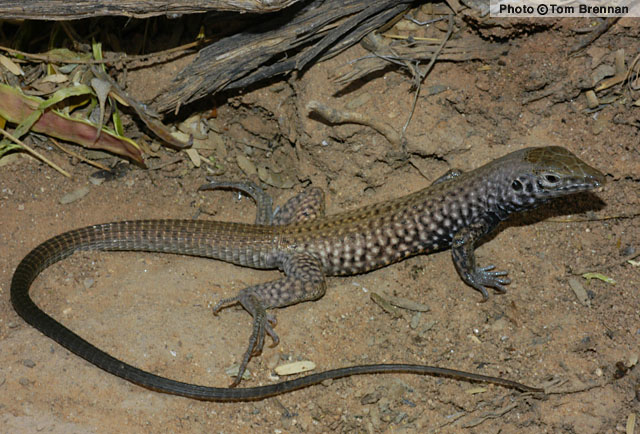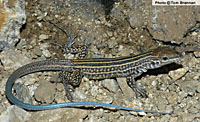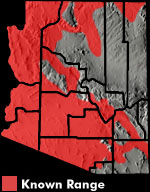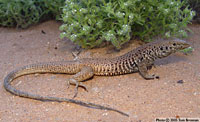Online Field Guide to The Reptiles and Amphibians of Arizona



Maricops County, AZ
 Juvenile. Maricopa Co., AZ |
| TIGER WHIPTAIL Aspidoscelis tigris | |
|
DESCRIPTION: A medium-sized (up to 110 mm or 4.3″ from snout to vent), slim, orange-brown to gray-brown lizard with a long, thin tail, and a slim, pointed snout. The body is marked with dark reticulations or marbling, light spots, and faint, light stripes. The reticulations are dark gray or black on the anterior portion of the sides. The tail is brown. Males have dark gray or black coloration on the chest and throat. Juveniles have a plain pale underside, distinct stripes, spots on the body and limbs, and a bright blue tail. As the animal ages the tail becomes brown, the stripes fade, and the spots often merge together into reticulations. The scales on the body are small and granular. The scales on the tail are large, keeled, and rectangular. The belly scales are large, smooth, and rectangular and the scales on top of the head are large, smooth, and plate-like. The similar looking Red-backed Whiptail is larger, has bright orange coloration on the lower back, and lacks dark markings on the sides and chest. HABITAT: Primarily an inhabitant of Arizona’s desertscrub communities. It also enters Semidesert Grassland and Interior Chaparral in some areas. This lizard occupies a wide variety of terrain types including sandy flatlands, plateaus, rocky bajadas, drainages, canyons, and steep mountain slopes. It is usually found in relatively open and sunny areas. BEHAVIOR: This is an alert, fast-moving, ground-dweller that actively forages during the day. It spends nearly all of its waking hours in motion foraging and moving between sun and shade for thermoregulation. It hibernates during the cold months of fall and winter. Young usually emerge from hibernation in March (about a month before adults) and remain active through October (about a month later than adults). This wary lizard can be difficult to capture. It is usually very conscious of its proximity to the pursuer and is careful to stay just out of reach. DIET: It actively forages by rooting around in organic matter under bushes and by digging in the soil around the bases of rocks, logs, and other surface debris. It feeds on termites, insect larvae, beetles, grasshoppers, butterflies, moths, and other insects. REPRODUCTION: The Tiger Whiptail mates in in spring and lays one or two clutches of eggs in late spring or summer. Clutch size ranges from 1 to 10 eggs. By Thomas C. Brennan Brennan, T. C., & A. T. Holycross. 2006. A Field Guide to Amphibians and Reptiles in Arizona. Arizona Game and Fish Department. Phoenix, AZ Brennan, T. C., & A. T. Holycross. 2005. A Field Guide to Amphibians and Reptiles of Maricopa County. Arizona Game and Fish Department. Phoenix, AZ Stebbins, R.C. 2003. A Field Guide to Western Reptiles and Amphibians, Third Edition. Houghton Mifflin Company, Boston, MA. |
 |
Visit Partners in Amphibian and Reptile Conservation:


HOME
Copyright © 2023, Arizona Game and Fish Department. All rights reserved.
If you make use of the textual contents of this site in reports, publications, etc. please cite and credit the author(s) and photographer(s). All photos on this website are copyrighted. However, those found in the species account section may be used for any noncommercial scientific, educational, or conservation purposes provided that photographs are not altered and continue to bear the copyright symbol and name of the photographer. Please contact the photographer regarding commercial use of copyrighted photographs.










